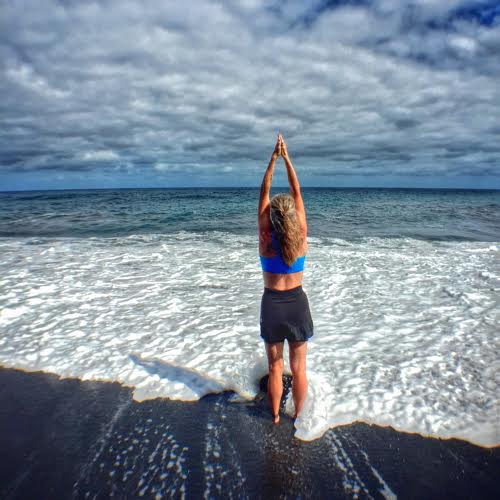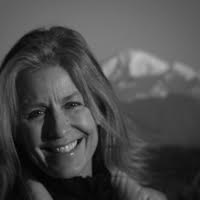
“Degenerative disk disease,” the orthopedic surgeon said flatly as he looked at my MRI on the screen. “Your disks have degenerated and you have bone on bone here.”
He pointed with his pen to my L2-L5 just above my sacrum. “Your spinal column is healthy, and your disks look like those of many 50-year-old women who have been as active as you. There isn’t anything I can do for you other than perhaps a prescription for an anti-inflammatory.”
If his attitude were a dog, I imagine it as a saggy-faced Shar Pei.
Million-dollar questions were adding up in my mind as his diagnosis began sinking in:
Can one live without vertebral disks the way some people live fully functional lives after a removed gallbladder?
If disks degenerate, can they regenerate like my liver?
If not, how long do I have before I am that bent woman whose lumbar spine has fused to her pelvis?
Apparently satisfied that his job was done, the orthopedic guy stuffed my MRI into a manila file folder, tucked it under his arm, stood, and made his way to the door with the body language of someone who had just discovered I had leprosy.
“I’ll pass on taking the prescription pain meds,” I said, “but I’ll take a prescription for physical therapy. Wouldn’t therapy be a helpful first step before I resort to painkillers?”
With a dismissive shrug indicating my suggestion was a cockamamie idea, he said, “I’ll leave a prescription for physical therapy with the front desk,” and jettisoned out the door in a manner that suggested a man suffering from irritable bowel syndrome.
As a devotee of an Eastern spiritual path for near 20 years, coupled with the genetic imperative of an athlete, I took to yoga like peas to carrots. Although it was love at first Anjali mudra, yoga and I had many false starts in the early years of our relationship and before my vertebral disks were suspect. A career that required I travel three weeks per month made our relationship a complicated one for the better part of ten years. As did moving to a tiny island in the Puget Sound of Washington State sans a yoga studio with a menu of offerings to fit my travel schedule.
Out of necessity, I developed a hotel and home practice. Then a coworker hooked me up with YogaGlo, which turned me into a virtual yoga junkie, and when my schedule permitted I would find the occasional studio in whatever city I found myself and do a drop-in.
On one such business trip to LA, I attended a class in which the instructor provided me with an unsolicited, and rather violent, adjustment to my apparently misaligned Urdhva Dhanurasana (a backbend). Crunch! My lumbar spine compressed as I winced in pain. The acute pain subsided within a couple of months. The sciatica pain I had experienced for years worsened. And a low-grade lumbar discomfort continued as a mild constant which I managed by using natural remedies and resuming my yoga practice devoid of the pretzel class of poses my inner athlete longed to execute.
With consistency of a gentler yoga practice I was able to take up cycling, then light jogging, and I was convinced that yoga had transformed my back and I was back to my normal, active self.
Then, during my home practice one predawn morning, I stepped my right foot forward into lunge and, zing!, pain seized my low back, dropping me to my knees as if I had been shanked in the kidneys by an unseen mugger.
The Right Choice for the Wrong Reasons
Fast-forward two years. Having had little success with the saggy-tude doctor and having investigated all the mainstream options my healthcare covered, I stopped short at risky steroid injections in my spine. A regimen of diet, gentle yoga and brisk daily walks was bushwhacking a trail through the wilderness of conventional approaches to chronic pain and providing a view of a “new normal” I had never pictured—one with arthritis of the spine.
Determined to beat the diagnosis, which felt like a life sentence to becoming the fused-back lady, I turned my attention to studying the mind-body connections to pain and to yoga on a hunch it had more to offer me.
As it turned out, physical therapy was not a cockamamie idea, but I’m not sure that enrolling in a yoga teacher-training course with my physical limitations wasn’t. I’m not a poster child for a yoga teacher, nor am I ready for an Instagram yogini shot. Yet, I am an A-type who’d had her sights set on earning my yoga teaching certificate long before my vertebral disks began taking leave of my spine.
Call me crazy, but that is what I did. I signed up for Therapeutic Yoga Teacher Training in Hawaii.
Aloha and Namaste!
Picture 25 people gathered from all parts of the globe, put them in a room with two gazillion-hour, multiple-acronym yoga trainers with over forty years of collective experience—one a Sanskrit-speaking surfer-yogini and the other a therapeutic yogic sadu + tantric-wise woman. To spice things up, make a disproportionate number of our group (teachers included) of the fiery-hot and sweaty pitta persuasion (as in the Dosha).
Our days began at 6:30 a.m. and ended at 6:00 p.m., all of them spent in a Quonset hut deciphering Patanjali’s crazy sutras, decoding Sanskrit, and learning pranayama breathing, anatomy, alignment principles, yamas, niyamas, doshas, koshas, kleshas, and the 8-Fold Path. And, of course, countless hours of yoga…done in Africa-like heat with Cambodian jungle-like humidity during a Hawaiian heat wave with record-breaking 100 percent humidity!
The training could have doubled for boot camp in Biloxi in July—an experience that shell-shocked my chakras, which had relaxed nicely over the past year and a half into the pajama-clad, coffee-slugging, freakish world of a writer.
“In the beginner’s mind there are many possibilities, but in the expert’s there are few.” Molly, our surfer-yogini instructor, quoted from the Zen masterpiece Zen Mind, Beginner’s Mind by Shunryu Suzuki Roshi as we began our practice early in Week One. Her selection was fitting and familiar; having read the Roshi’s book and practiced his Zen idea, I welcomed his words. Hearing them was like a firm but kindly tap on the shoulder of my mind, reminding it to ditch the preconceived notions, the ever-ready opinions, and to shut the f*** up and begin anew.
As I emptied my mind of content, new words, new meanings and new ways to engage muscle and align bone began filling the empty spaces, and I indeed entered into a space of yoga I knew little about. For starters, Patanjali’s sutras 2.46-2.48, which state that when we practice with sthira and sukha (steadiness and ease), we apply a steadiness of focus and seek a stable foundation, and—wait for it—find a comfortable posture! Who knew?
Patanjali goes on to suggest that, in this way, we have a shot at liberating our unobstructed, already present, authentic nature. From this place we are free from the unnecessary suffering we cause ourselves (and others) by clinging to opposing ideas of right and wrong, good and bad, like and dislike, pleasure and pain.
Back to the Beginning
“Unite the breath with the movement—with steadiness and ease.”
“Ground down through all four corners of your feet.”
“Spread your toes wildly!”
“Thighs back.”
“Widen your hips.”
The instructors’ clear cues began to spiral through my awareness, helping to connect me to the here and now of my experience, the way my mantra practice connects to the spinning of my mala beads and grounds me in the present moment. With my breath threaded to the actions, I moved beyond clinging to past ideas of pain, and future ideas of healing. With practice, I experienced unimpeded movements, pelvis bowl shifting into widened hips, and places in my body that seemed locked were becoming open and accessible.
I felt a buoyancy—dare I say, liberation—sensing the possibility of a life with arthritis beyond a “me” identified by pain.
The million-dollar question I hear you asking: “Did yoga teacher training regenerate your disk and are you pain free?” Hell, no! And it for damn sure didn’t stop my crazy mind from being, well, crazy.
What yoga teacher training did was set my context straight for the healing journey ahead, the way a compass points to true north. This context assumes that I am already a whole Self, and does not assure some mystical safe passage through the inevitable suffering of life. It has been said of the dharma practice from my Buddhist leanings that the dharma is a tool intended to protect me from falling prey to the illusion that suffering and pain are to be avoided, or—worse—that these are all illusion! This right context for my spiritual practice is, it seems, not separate from the context for practicing—or teaching—yoga.
My reason for taking yoga teacher training was cockamamie, but I did the right thing.
The training helped me mature in my practices, and this brought relief from the unnecessary suffering that my clinging to a past me, and wishful thinking about a future me, was causing. And what’s more, it’s authentic. And perhaps this is my whole, higher Self.
Or, I might say, my Buddha nature.
*Author’s Note: Special thanks to my editor, Nancy Lewis, for her help with this piece!
Author: Tarini Bauliya
Editor: Emily Bartran
Photo: Author’s Own










Read 0 comments and reply